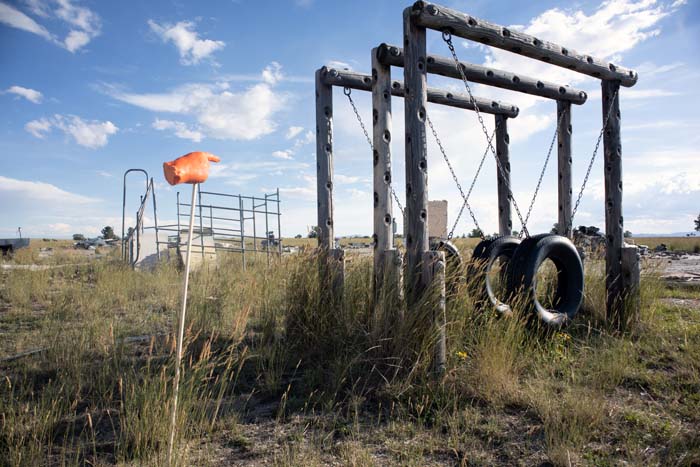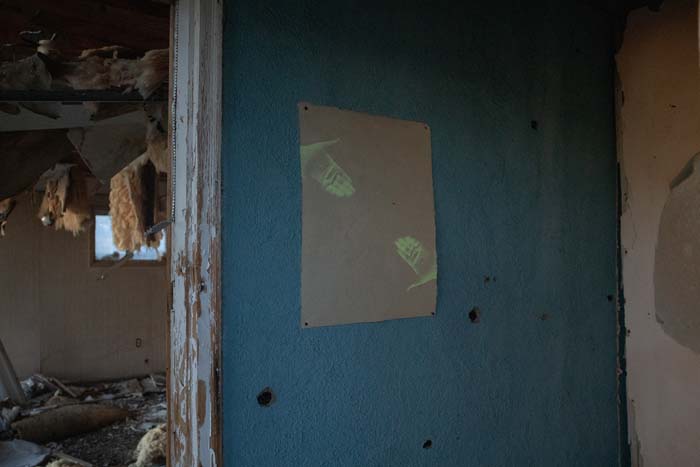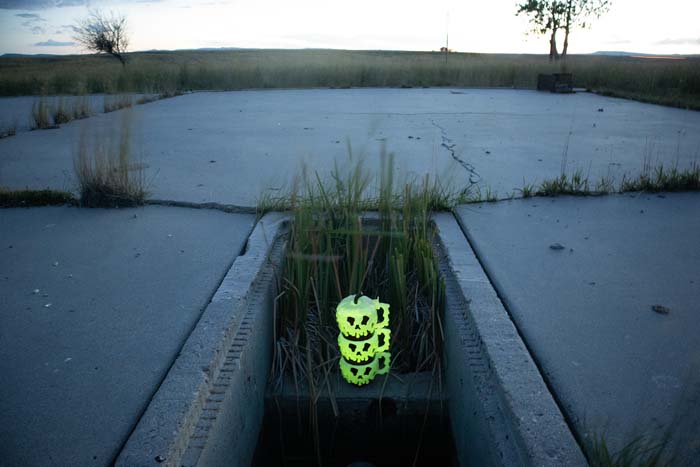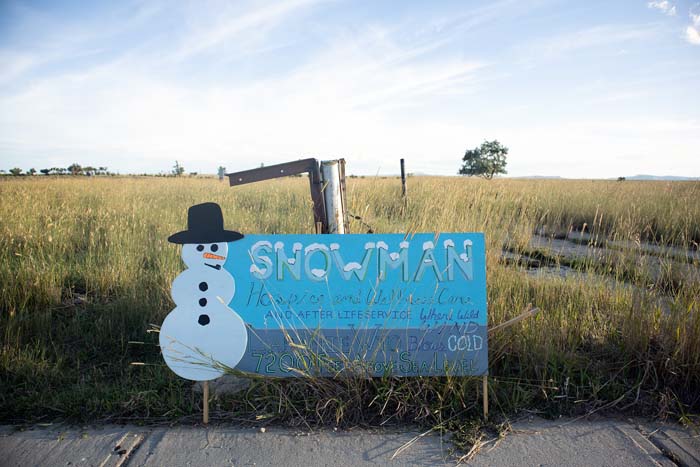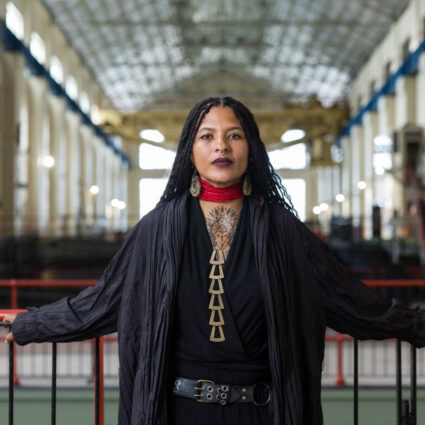If you can find it, Wyoming’s uranium mine ghost town Shirley Basin will surprise you with a treasure trove of eclectic art from Hyperlink and Land Report Collective members.
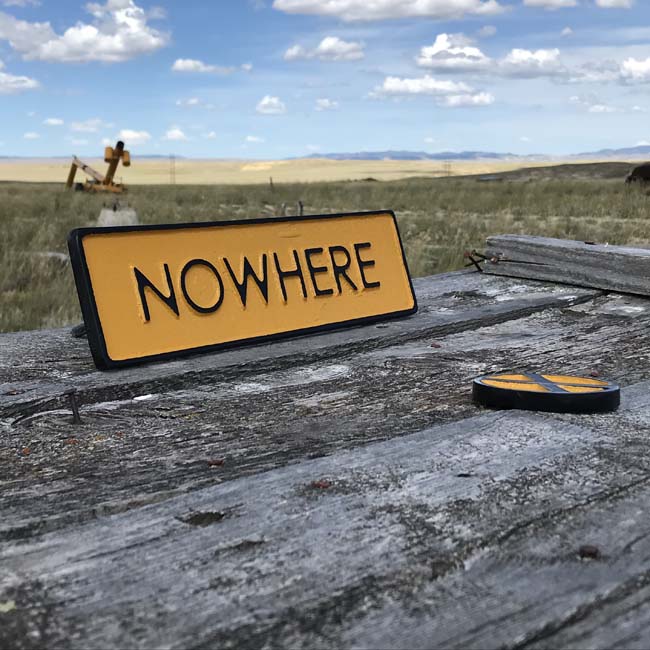
Hyperlink and The Land Report Collective: Re-Activate
August 18, 2023–ongoing
Shirley Basin, Wyoming, on a piece of Bureau of Land Management land between Casper and Medicine Bow on the east side of Highway 487
Sitting forgotten on an unmarked county road on the east side of Highway 487, you probably won’t find Shirley Basin, Wyoming, a uranium mine ghost town founded nearly seventy years ago. Its remote coordinates place it beyond unimpeded prairie hills, thirty miles north of Medicine Bow and sixty-seven miles south of Casper. If discovered, your reward is an eyeful of unhurriedly toppling structures, letting you witness more than three decades of ongoing decay and abandonment.
The town reminded me of “There Will Come Soft Rains,” a vignette from Ray Bradbury’s The Martian Chronicles (1950) in which an AI home automates breakfast and other tasks for a missing family that perished in an assumed nuclear catastrophe. Writing at the onset of the Cold War and imagining the near future of the 2020s, Bradbury feared global destruction. Yet, with the 1979 partial meltdown of a plant in Pennslyvania, demand for uranium declined. By the 1990s, the populations of Wyoming’s mining towns dwindled, or, as with Shirley Basin, completely emptied.
Like the house in Bradbury’s story, the persevering ruins I explored strived to serve absent inhabitants. Indeed, as Hyperlink artists Theresa Anderson, Alicia Ordal, and Julie Puma erected their mixed-media sculptures in the only copse of still-standing trailers, the town blossomed under returned human interest.
These artists traveled from Denver to participate in Re-Activate, a group show in collaboration with the Land Report Collective, which shares Hyperlink’s mission to meaningfully unite artists with various communities. Including geographically dispersed members from Colorado, Georgia, New Mexico, Oklahoma, Tennessee, Washington, Wyoming, and more, these collectives also seek to connect creatives across physical and digital boundaries and barriers.
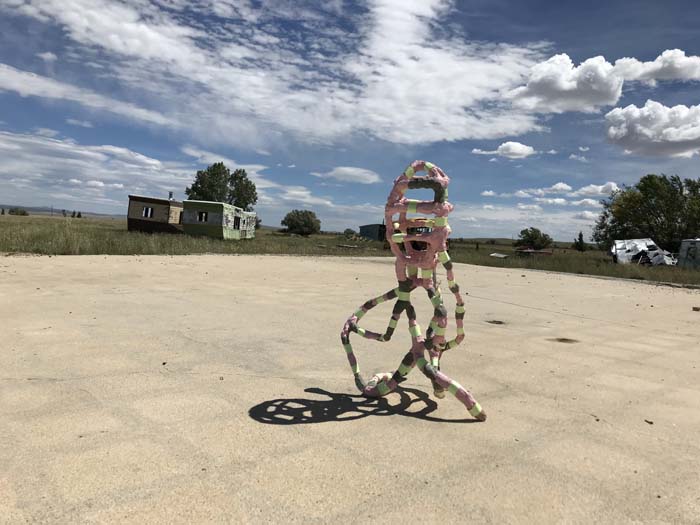
In 2020, Hyperlink artists Tobias Fike and Donald Fodness imparted to the Land Report Collective’s Shelby Shadwell and David Jones their desire to exhibit in a ghost town. Originally researching Colorado towns, Shadwell and Jones told them about Shirley Basin and preparations for Re-Activate percolated.
While I witnessed a sliver of these artists’ toil in beautifying the area on the third Saturday in August, previously installed art hid among the dross. Additionally, beyond a second round of installation in October, both groups will maintain and replenish Re-Activate’s exhibition over the next few years.
On my own unguided treasure hunt for art, I found a small, windowless white building with an attached cylindrical metal tower, I trepidatiously tip-toed through the open door next to Patrick Kikut’s Snowman Hospice and Wellness Care billboard (2020), with a snowman advertising a snowman hospice in Laramie, Wyoming. Although I wasn’t trespassing, I felt like an intruder needing a hazmat suit to explore the depths of this miniature Chernobyl. Yet no uranium was mined and no nuclear reactors exploded in this spot.
Inside were tall boxes with switches, dials, and gauges—clunky technology from a bygone telecommunications era. A disorderly vomit of binders and files spilled across the floor. Above me hung Daisy McGowan’s Biopsychosocial (all works 2023 unless otherwise noted), a disco ball, which, at night, scatters luminescent confetti onto an uninviting dance floor.
Alongside McGowan’s piece, many of the objects peppering this post-apocalyptic plot announce themselves at gloaming when solar-powered spotlights illuminate them, such as one of Ian Fisher’s cloud paintings, Atmosphere No 81 (Bridges), on a wooden pole. Glow-in-the-dark material and paints also lend an absinthe radiance to Fodness’s Poison Apple Stack, a tower of melting skull mugs and epoxy, and Summer Ventis’s screen print on kitakata paper depicting a pair of hands, Extraction: Half-life. Meanwhile, Fike’s spotlighted hand sculptures of plaster, orange paint, and wood, Point of Interest (1-3), point to structures and pose the question: is this a curated item or serendipitous debris?
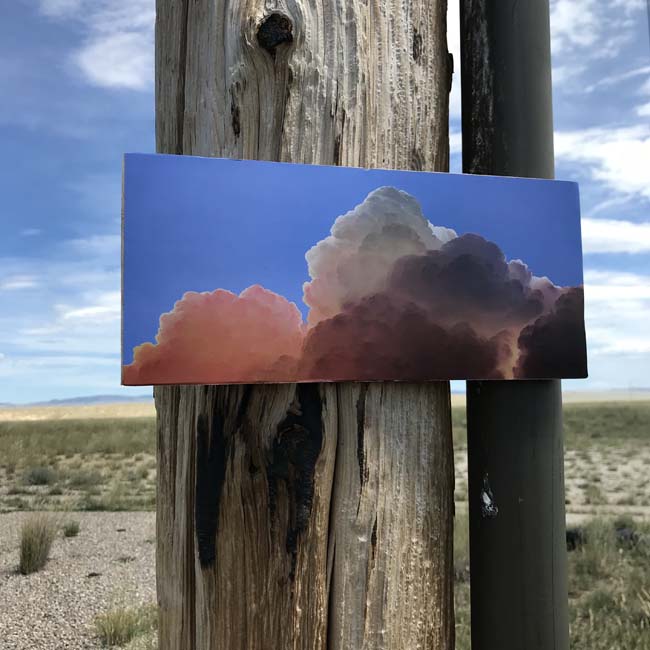
Thinking about this question, I circled a pile of cinder blocks next to a dismantled jungle gym, evidencing a former school building that also looked like a bomb detonation site. I took photos of a tangled mound of wires and cables, symmetrical rows of tattered floor tiles, and a tall metal figure resembling a tin man next to a fragmentary jut of brick wall. While no work was yet installed there, these remnants’ colors, textures, and gestures invited my camera lens, begging to be apotheosized among the artists’ work. A wonderful and grotesque symbiosis was emerging—while the art elevated the cultural value of the surrounding waste, the waste, in turn, besmirched the art with the paranoia of contamination.
In the wake of the COVID pandemic, Shirley Basin feels particularly rife with contagion—not to mention potential zombie takeover—validating the Red-gun-state need to bear arms where no one will hear your struggles with unprecedented antagonists. Indeed, many objects in the vicinity—the sides of trailers, truck beds, an empty school bus—are tantalizingly perforated with bullet holes, prognosticating that all of the artworks will eventually become target practice, too.
Anderson, Ordal, and Puma had nearly finished setting up their work when I found them in a mint-green trailer. They lined up Puma’s untitled, bell-jar-encased objects in a kitchen already decorated with vintage wallpaper in a muted brown, yellow, and green palette. All the cabinets were thrown open as if a tornado or poltergeist had stormed through, but Puma chirped in oblivious, home-keeping bliss.
Outside, Anderson’s powerline (past-present-future), made of worn pantyhose and pigmented pillow-soft foam, hung like an alien’s laundry line off the end of an imploded silver trailer. Ordal’s Tailings, a flamboyant metal, concrete, and yarn sculpture, most noticeably transformed the landscape in its scale and color. Building on top of a wheel-less, red-orange truck bed, Ordal placed a cuboid, antenna, and rope. All were spray painted neon green—the mythical, comic-book hue of radioactivity.
As the sun disappeared giving way to fire tones before an indigo twilight, we lingered in the dark to document the phosphorescent artworks. Then, dodging herds of elk on the side of the highway, we returned for a second night in Medicine Bow’s purportedly haunted Virginian Hotel. At the hotel bar, with an array of mysteriously fragmented paintings of Old West outlaws such as Butch Cassidy, the Hyperlink artists and I discussed the probability of creating a map with directions to the exhibition, including a key for the displayed work.
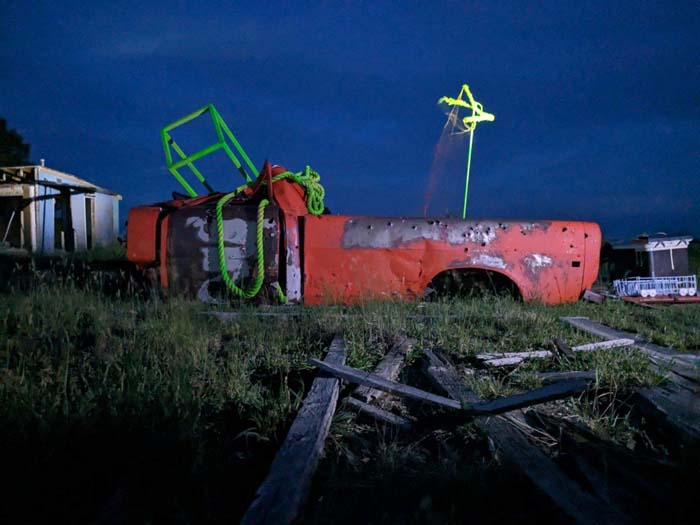
“You should leave it here, at the hotel, and start an unofficial partnership,” I suggested.
“Yes, we already thought of that,” Fike, who had joined us in the late afternoon, answered. He elaborated on how lodging at a place like the Virginian was part of the experience he wanted to curate. All of the artists beamed with the possibility of increasing foot traffic to this non-destination with a transient population of oil rig and highway workers.
Their gusto made me wish that I, too, was an artist invited to visually convey my perverse fascination with a place still bearing the scars of economic, ecological, and industrial devastation. Instead, I shared their productive curiosity about Shirley Basin and their excitement for an exhibition that compellingly blurs the distinction between art and detritus.

